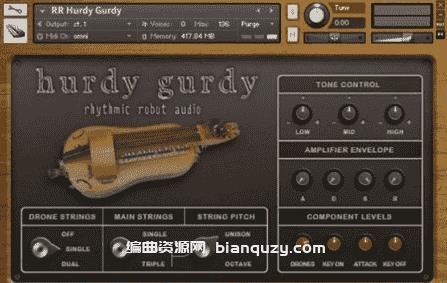
DISCOVER | 24 March 2015 | 439 MB
手摇琴是一件奇妙的东西:一个由手摇木轮和一把钥匙驱动的、发出铿锵声、发出嗡嗡声的声音盒子。
它可以听起来轻快愉快,也可以听起来令人难以忘怀的哀伤;它可以驱动很难得到一个真正的原始攻击的音符,或放松回平滑和微妙的效果。它复杂而有机,令人回味无穷。
它的工作原理是用松香木轮摩擦小提琴风格的弦,包括固定音高的低音弦和可演奏的旋律弦,它们通常相隔一个八度。有时还可以调整低音(例如,调到完美的五度),为旋律添加开放的和弦伴奏。
现实生活中的hurdy-gurdy是一种单音乐器,每次一个音符,除了低音,但我们的hurdy-gurdy可以选择遵循传统或打破它,如果你喜欢,可以演奏和弦。
在效果面板上有一个非常好的混响,给你的声音一点喘息的空间,加上合唱,回声,旋转扬声器和安培驾驶室模拟,如果你想把你的hurdy-gurdy通过相当于吉他手的踏板。不是很真实,但是很有趣!
Hurdy-gurdies是出了名的反复无常和任性的乐器。他们只是做得不够原始和精确。事实上,手风琴演奏者说,要演奏手风琴,你必须花两个小时来调音;然后用一个小时弹,跑调。
我们的Hurdy Gurdy也不例外:我们几乎没有试图掩饰声音令人兴奋的不均匀和不稳定的本质(好吧,我们调整了最糟糕的走调者,但总的来说,你得到的是真正的交易,疣和所有)。
手摇琴弦引入了音调颜色和振幅的周期性变化,你可以通过使用键盘上的模轮来控制Hurdy Gurdy的音量来添加你自己的,更刻意的变化。
这是一种非常直观的方法,让乐器像真正的玩家一样脉动和呼吸,经过一些练习,它变成了第二天性,有节奏地“骑”模轮来模拟手柄的转动。
Hurdy Gurdy做了两件事给你很大程度的真实性。首先,它将仪器设置的几个重要方面置于您的控制之下。你可以选择多少无人机和多少主弦你想玩-一个简单的,剥离回来的声音或更充分,更丰富的音色。
您也可以选择之间的一致和八度主弦。您还可以精确地控制Hurdy Gurdy音调的最具特色的方面-键噪声和当挂钩接触琴弦时发生的攻击“啁啾”。
键开和键关的噪音可以独立调节:设置这些高会导致一个非常“嘎嘎”的声音,如果hurdy-gurdy已经接近牛奶,而拨回他们有助于模拟听到乐器在更远的距离。
攻击的“唧唧声”或尖叫绝对是hurdy-gurdy的特征,也是其身份的一个组成部分,但如果你愿意,你可以降低甚至去掉它,这导致声音更像民间小提琴或小提琴。
这也可以让你用一个好的老式合成器风格的ADSR信封来控制弦的音调,以防你想把Hurdy Gurdy推向陌生的新领域(尽管如果声音设计是你的事情,你可能会对Hurdy Gurdy的姐妹乐器,曲柄感兴趣。)
其次,Hurdy Gurdy在幕后做了很多聪明的事情来模仿真实的文章。对于每个音符,采样了两组完全不同的攻击啁啾,一组是低音调,一组是高音调,因为hurdy-gurdy产生的声音截然不同,这取决于你是敲击比演奏音符高的音调,还是释放一个键让音调回落到较低的音符。
这种水平的细节结合了大量的样本,巧妙地随机化,以确保没有两个音符听起来完全相同。(每个音符都有20个不同的攻击啁啾,超过一分钟的持续音调,以及200个潜在的键击和释放噪音!)
最终的结果是一种硬壳的、不均匀的、颤抖的、飘忽不定的美。这是一种有着数百年历史的乐器:一个民间音乐家的神奇的声音盒子。现在它可以把它的吉普赛魔法带到你的混合。
The hurdy-gurdy is a marvellous thing: a thrumming, resonating, buzzing box of sound, driven by a hand-cranked wooden wheel and a fistful of keys.
It can sound brisk and cheerful or hauntingly plaintive; it can be driven hard to get a really raw attack to the notes, or eased back for a smoother and subtler effect. It’s complex and organic and wonderfully evocative.
It works by rubbing a rosined wooden wheel against violin-style strings, which include both fixed-pitch drones and playable melody strings, which are often tuned an octave apart. The drones can also sometimes be tuned (for example, to a perfect fifth) to add an open chordal accompaniment to the melody.
A real-life hurdy-gurdy is a monophonic instrument – one note at a time, apart from the drones – but with ours you can choose to follow tradition or break with it and play chords if you like.
On the Effects pane there’s a very nice Reverb to give your sound a bit of breathing space, plus Chorus, Echo, Rotary Speaker and Amp Cab simulations in case you want to put your hurdy-gurdy through the equivalent of a guitarist’s pedalboard. Not very authentic, but good fun!
Hurdy-gurdies are notoriously fickle and wayward instruments. They simply don’t do pristine and precise. In fact, hurdy-gurdy players say that to play the hurdy-gurdy, you must spend two hours tuning it; and then one hour playing it… out of tune.
Our Hurdy Gurdy is no different: we’ve made barely any attempt to disguise the excitingly uneven and erratic nature of the sound (okay, we tweaked the worst out-of-tune offenders, but generally what you get is the real deal, warts and all).
The hand-cranked strings introduce periodic variations of tone colour and amplitude, and you can add your own, more deliberate, variation by using the mod wheel on your keyboard to control Hurdy Gurdy’s volume.
This is a very intuitive way of making the instrument pulse and breathe just like a real player would, and after a bit of practice it becomes second nature to ‘ride’ the mod wheel rhythmically to simulate the turning of the handle.
Hurdy Gurdy does two things to give you a great degree of authenticity. Firstly, it puts several important aspects of the instrument’s setup under your control. You can choose how many Drone and how many Main strings you want playing – for a simple, stripped-back sound or a fuller, richer timbre.
You can also select between unison and octave Main strings. You also get a precise degree of control over the most characterful aspects of Hurdy Gurdy’s tone – the key noises and the attack ‘chirp’ that occurs when the pegs contact the strings.
Key On and Key Off noises can be adjusted independently: setting these high will result in a very ‘clacky’ sound as if the hurdy-gurdy has been close-miked, while dialling them back helps simulate hearing the instrument at more of a distance.
The attack ‘chirp’ or squeal is absolutely characteristic of the hurdy-gurdy and an integral component of its identity, but if you want you can lower this or even remove it, which results in a sound more like a folk fiddle or violin.
This also lets you control the string tone with a good old synth-style ADSR envelope, in case you want to push Hurdy Gurdy into strange new areas (though if sound design is your thing, you may be interested in Hurdy Gurdy’s sister instrument, Crank.)
Secondly, Hurdy Gurdy does a lot of clever stuff behind the scenes to mimic the real article. Two entirely different sets of attack chirps were sampled for each note, one slurring down to pitch and one slurring up, since the hurdy-gurdy produces a distinctively different sound depending on whether you hit a key of a higher pitch than a playing note, or release a key to allow the pitch to drop back to a lower note.
This kind of level of detail combines with a huge number of samples, cleverly randomised, to ensure that no two notes sound quite the same. (Each note draws on 20 different attack chirps, over a minute of sustained tone, and two hundred potential key strike and release noises!)
The end result is a triumph of crusty, uneven, tremulous, erratic beauty. This is an instrument with hundreds of years of heritage behind it: a folk musician’s magical box of sounds. Now it can bring its gypsy magic into your mix.






